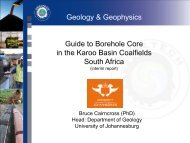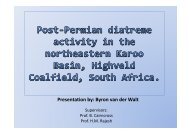coaltech upper olifants river catchment wetland inventory ...
coaltech upper olifants river catchment wetland inventory ...
coaltech upper olifants river catchment wetland inventory ...
You also want an ePaper? Increase the reach of your titles
YUMPU automatically turns print PDFs into web optimized ePapers that Google loves.
Sixteen fish species (four of which were exotic) were analysed for the presence of metals<br />
and pesticides by Heath and Claassen (1999). Representative specimens in each of the<br />
species were analysed. There is a dietary difference between species in different <strong>river</strong>s, and<br />
this may also influence comparisons between <strong>river</strong>s. A marked difference exists between<br />
accumulation of different metals in different tissues such as the liver, gills, ovaries and<br />
testes. The different tissues were, therefore, analysed for each of the metals. The mean<br />
metal value per tissue was converted to ųg/l as a common unit. The result of the study was<br />
that fish can be used as indicators of pollution and that the bio-accumulation of metals and<br />
pesticides is taking place in the Olifants River. The bio-accumulation of pesticides such as<br />
DDT may be from past usage of the pesticide within the <strong>catchment</strong> (Heath and Claassen<br />
1999).<br />
3.8 Wetland inventories<br />
3.8.1 National Landcover database<br />
The <strong>wetland</strong> layer in the National Landcover was updated. The scale of the <strong>wetland</strong> cover is<br />
approximately 1:250 000. The expected date of release to the public is not yet known,<br />
however it is expected that the data will be released very soon, since the <strong>wetland</strong> layer was<br />
completed in July 2006.<br />
3.8.2 Endorheic pans (Allan et al 1995)<br />
A synthesis of all literature on the pans in the Transvaal and Free State was compiled by<br />
Allan et al (1995). The report included the definition, distribution, density and the size of<br />
pans. The distribution map is on a very small scale (approximately 1:9 000 000), and is<br />
therefore, difficult to identify the locations of pans in the UORC. The classification of pans<br />
and the difficulties experienced in classifying pans are discussed, as well as, the possible<br />
origin and maintenance of the pans. The report includes a section on the abiotic and biotic<br />
characteristics of pans, as well as, a section on threats to the pans (Allan et al 1995).<br />
Wetland Database for UORC - 59 -




